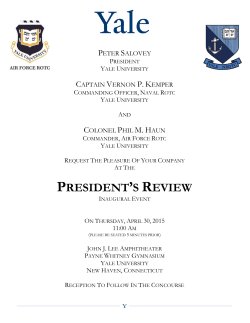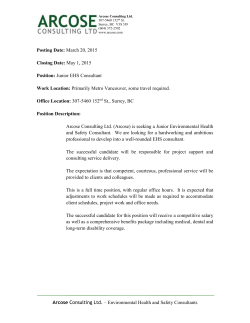
Laboratory Closure and Decommissioning Policy
Yale University – Environmental Health & Safety LABORATORY CLOSURE AND DECOMMISSIONING POLICY Yale University is committed to the health and safety of its students, faculty, staff and visitors as well as the surrounding community and environment in which Yale personnel conduct their studies, scholarship, and work. The goal of this Policy is to ensure safe and compliant transitions in laboratory occupancy. More specifically, in order to protect others when an investigator vacates laboratory space, this Policy requires that none of the investigator’s research materials may be left behind in the laboratory. Further, the Policy requires that the investigator assure that proper laboratory decommissioning has been conducted, e.g., that all laboratory equipment, fixtures, furniture and space are properly cleaned and decontaminated. Principal Investigators, Departments and Project Managers are equally responsible for complying with advanced notification and other requirements. These overlapping requirements are necessary because—depending on the situation—only one of these entities will have the ability to comply with this Policy. This Policy will be administered by Yale Environmental Health and Safety (EHS). APPLICABILITY This Policy applies to: • Research and teaching laboratories owned by Yale or occupied by Yale students, faculty or staff. • Laboratories that use chemicals, radioactive materials, biologicals, human pathogens, controlled substances, compressed gases, large equipment, mercury containing monitors, etc. • Laboratories or ancillary research spaces (e.g., cold rooms, freezers in hallways) that are vacated by an investigator. • Laboratory space that is to be reused by a different investigator, as well as laboratory space that is to be converted to another use. • Movement of safety critical equipment. BACKGROUND This Policy is necessary for the following reasons: • EHS oversight of laboratory decommissioning and transfer ensures transportation and licensing compliance. If EHS is not contacted in advance of a laboratory closure, there is a high risk of unsafe and/or noncompliant transport of research materials. • The U.S. Environmental Protection Agency generally requires: o Within three days of vacating a laboratory, all chemicals must be removed. o Prior to vacating a laboratory, laboratory personnel (who are most knowledgeable) must properly label and/or identify all remaining chemicals, samples and containers. • Prior to vacating a laboratory, the U.S. Nuclear Regulatory Commission requires removal of all radioactive materials and waste. No radioactive material or waste may be unsecured. Page 1 – Prepared by Kevin Charbonneau – 8/11/09, revised 5/19/15 Yale University – Environmental Health & Safety • • • • • • Prior to vacating a laboratory, the U.S. Drug Enforcement Agency and the State of Connecticut requires removal of all controlled substances. No controlled substance may be unsecured. Prior to vacating a laboratory, the State of Connecticut requires removal of all human pathogens and infectious waste from research with human pathogens. Laboratory equipment, fixtures, furniture and space that has not been properly cleaned and decontaminated may pose a hazard to EHS staff, movers, construction and renovation personnel and future occupants. Research materials (e.g., chemicals, biologicals, radioactive materials, needles) left in a vacated laboratory pose hazards to EHS staff, hazardous waste contractors, construction and renovation personnel, and future occupants. These are extreme hazards when such materials are unlabeled, unidentified, unstable, improperly stored, contaminated or improperly contained. When unsecured in a vacant laboratory, these research materials are also at risk of theft, diversion and misuse. Research materials that are not promptly removed from a vacated laboratory are ineligible for redistribution or recycling making disposal the only viable option. Disposal costs are dramatically more expensive than recycling/redistribution costs due to extra characterization and necessarily conservative handling. To ensure safety, safety critical equipment must be certified in place. Prior to use, EHS must recertify all safety critical equipment that has been moved. The Principal Investigator and his or her laboratory staff are primarily responsible for complying with this Policy because they are most knowledgeable (and may have the only knowledge) of the identity, character and hazard of materials and contamination in their laboratory. EHS RESPONSIBILITIES When an investigator vacates laboratory space, EHS is responsible for verifying that the space is free of hazardous materials and contamination. EHS will complete this verification in a timely manner, and will provide a written approval to the department (for new occupancy) or project manager (for space to undergo construction/renovation). • EHS staff will provide detailed instructions and guidance to investigators and their staff in advance of all laboratory moves, closures and decontamination, including requirements for labeling and identification of research materials. • EHS staff will evaluate and provide guidance for the movement of research materials. The EHS Research Materials Shipment Request form can be found at the following link: http://ehs.yale.edu/research-materials-shipping. If the materials in question are to be moved on city streets and lab staff are not trained to properly package and/or ship these items, EHS will provide a trained individual to assist in this process. Each Principal Investigator will be responsible for the cost of the shipping containers as well as all incurred shipping charges. • EHS will pay for the removal and ultimate disposal of all properly labeled and classified research materials. If research materials are inappropriately left after the space is vacated, EHS will arrange for the proper disposal and decontamination. The costs of these activities, including labor charges to properly segregate and label hazardous materials, will be charged directly to the investigator. Page 2 – Prepared by Kevin Charbonneau – 8/11/09, revised 5/19/15 Yale University – Environmental Health & Safety PRINCIPAL INVESTIGATOR RESPONSIBILITIES Each investigator is responsible for: • 30 Day Notification of Laboratory Vacancy: To ensure proper characterization and disposition of research materials and decontamination of laboratory equipment, fixtures, furniture and space, investigators must notify EHS 30 days prior to vacating laboratory space. EHS notification is required even if only a single room is to be vacated, and even if the space is to be used by another investigator. • The safety of materials and equipment, including the safety and compliance of materials and equipment left behind in a vacated laboratory, even if the laboratory is to be used by another Principal Investigator. • Adherence to established Yale Environmental Health and Safety procedures for safe and compliant disposal and decontamination of research materials. If these procedures are not followed, EHS will arrange for the proper disposal and decontamination, as it deems necessary. The costs of these activities, including labor charges to properly segregate and label hazardous materials, will be charged directly to the investigator. • Ensuring that research material cleanouts are performed by staff knowledgeable of hazards and trained in all required safety disciplines. • Informing EHS prior to the shipment or movement of any hazardous materials especially those requiring transportation on city streets. The EHS Research Material Shipment Request form can be found at the following link: http://ehs.yale.edu/research-materials-shipping • .Notification of EHS whenever they plan to move any of the following safety critical equipment, even if the move is across a room or from one room to another (see Attachment 2 for detailed clearance requirements): Autoclaves Automated film processors Biological safety cabinets Clean Benches (Horizontal or Vertical Laminar Flow) Compressed Gas manifold delivery systems Electron microscopes Ethylene oxide sterilizers Fume hoods Gamma counters (or gamma detectors) Glove boxes High Magnetic Field Equipment Lasers - Class IIIb or IV Liquid scintillation counters (LSC) Refrigerators/Freezers X-ray equipment Page 3 – Prepared by Kevin Charbonneau – 8/11/09, revised 5/19/15 Yale University – Environmental Health & Safety DEPARTMENTAL RESPONSIBILITIES Department Chairs and Business Managers are responsible for: • 30 Day Notification of Laboratory Vacancy: To ensure proper disposal of research materials and decontamination of laboratory equipment, fixtures, furniture and space, Departments must notify EHS 30 days prior to vacating laboratory space. EHS notification is required even if only a single room is to be vacated, and even if the space is to be used by another investigator. • The costs of decontamination and disposal of research materials in situations where there has been a failure to meet the requirements listed in the Investigator Responsibilities section and those costs cannot be recovered from the investigator. • Securing written approval from EHS before reassigning vacated laboratory space. • Securing written approval from EHS before initiating construction or renovation in vacated laboratory space. • Ensuring that research material cleanouts be performed by staff knowledgeable of hazards and trained in all required safety disciplines, including temporary hires on an as needed basis. PROJECT MANAGER RESPONSIBILITIES Project Managers who are assigned laboratory renovation projects are responsible for: • 60 Day Notification of Laboratory Vacancy: To ensure proper disposal of research materials and decontamination of laboratory equipment, fixtures, furniture and space, Project Managers must notify EHS 60 days prior to vacating laboratory space. EHS notification is required even if only a single room is to be vacated, and even if the space is to be used by another Principal Investigator. • The costs of laboratory renovation projects that relate to decontamination and research material disposal. • Ensuring that vacated laboratory space is not re-occupied without prior written approval from EHS. • Ensuring that construction or renovation not commence in vacated laboratory space without prior written approval from EHS. SUPPLEMENTARY GUIDANCE AND REFERENCES Yale Environmental Health and Safety procedures can be found on its web site: • “Vacating a laboratory,” Yale EHS, http://ehs.yale.edu/vacating-lab . • “Hazardous waste disposal procedures,” Yale EHS, http://ehs.yale.edu/waste. • “Research Material Shipping Info.,” Yale EHS, http://ehs.yale.edu/research-materials-shipping. Laboratory Decommissioning Standard, ANSI Z9.11 (2008), American National Standards Institute Yale Facilities Operations: • “Facility Services,” Yale Facilities, http://facilities.yale.edu/yale-university-office-facilities COMMITTEE REVIEWS and APPROVALS: Biosafety – 8/7/09 Radiation Safety – 6/8/09 University Safety – 8/11/09 Page 4 – Prepared by Kevin Charbonneau – 8/11/09, revised 5/19/15 Yale University – Environmental Health & Safety Attachment 1 Laboratory Move Preparation Guide Before any laboratory move or closure can occur, the following preparations must take place. General – all laboratories: 1. Depending on the size and scope of the move, stop research activities 1-2 weeks prior to move. Contact your Safety Advisor or EHS to help estimate the time commitment. 2. Clean off all benches. Remove lab matting and clean any spilled materials. Wipe down all benches with an appropriate disinfectant. 3. Completely empty all drawers. 4. All razor blades, needles, syringes, pipette tips, etc. in drawers, on benches, shelves or the floor must be disposed of properly. 5. If research materials must be shipped to another location or institution, a hazmat shipping request form must be completed via the following link: http://ehs.yale.edu/research-materials-shipping. Do not ship any material until contacted by EHS. Radiation Safety Preparations: 1. Collect all radioactive waste and contact EAS to schedule a pick-up. Pick up requests can be emailed to waste.requests@yale.edu; it may take up to 5 business days for waste removal. 2. Items which will be moved by non-lab personnel or which will be discarded must be cleared by EHS. 3. For in-house moves in which items stay inside buildings and are moved by laboratory staff, no EHS clearance is necessary. Laboratory staff must wipe test and meter these items. 4. Radiation which is moved inside buildings may be properly packaged in 2 sealed leak-proof containers, placed on a cart and taken to the new location by trained lab staff. Care must be taken to ensure that proper shielding is in place, if necessary. EHS personnel should be consulted if large amounts of isotope or isotope with significant dose rates are to be moved. 5. Do not deface labels on equipment to be checked by EHS until it is cleared. 6. Assemble all labeled items (large items may be left where they are) for EHS to clear. 7. Conduct a final monthly survey of the lab. Clean any contamination found and re-survey and document results. Page 5 – Prepared by Kevin Charbonneau – 8/11/09, revised 5/19/15 Yale University – Environmental Health & Safety Chemical Safety Preparations: 1. Clean any equipment used with hazardous materials. 2. Hazardous waste and unwanted chemicals must be labeled as hazardous waste and inventoried on a laboratory clean-out sheet. Contact EAS for pick up by emailing waste.requests@yale.edu. 3. Non-hazardous dry chemicals listed in Appendix E of the Hazardous Waste Policy and Procedures Manual (pg 39) may be properly packed and moved within buildings. All other chemicals must be evaluated by EHS or packaged and shipped by an EHS approved hazmat transporter. http://ehs.yale.edu/sites/default/files/hazwaste manual chemical section.pdf 4. Chemicals which are moving within University buildings must be placed in a leak proof secondary container. Chemicals may be placed on a cart and moved by lab personnel. 5. Have all gas cylinders removed by the vendor. Biological Safety: 1. Use an appropriate disinfectant, prepared in accordance with manufacturer’s instructions, to decontaminate all equipment. Post a “Biosafety Notice” on each item once decontamination procedures have been completed (See Attachment 3). 2. Properly autoclave/dispose of all infectious/biological waste. 3. Ensure biosafety cabinet (BSC) has been decontaminated. Call the BSC service coordinator at 203-737-2121 to schedule a decontamination appointment at least 7-10 working days prior to the anticipated move date. Decon should be performed at least 2 days pre-move. 4. Properly dispose of all sharps, including unused needles and syringes. 5. Biological material moved within buildings must be packaged in 2 sealed leak-proof containers and should be placed on a cart and moved to new location by lab personnel. Within University buildings, the moving company may move BL1 or BL2 materials in -80 freezers if the materials are properly packaged in 2 leak proof containers by the laboratory personnel. Prior to moving company arrival: • All chemicals must be removed from laboratory. • All waste must be out of the laboratory. This includes chemical, biological and radioactive waste. • All benches must be decontaminated. After the moving company has finished: • Ensure that all sharps (razors, syringes, needles, pipette tips, etc.) have been removed from areas where equipment may have been, including drawers and shelves Page 6 – Prepared by Kevin Charbonneau – 8/11/09, revised 5/19/15 Yale University – Environmental Health & Safety Attachment 2 Laboratory Move Checklist Equipment Biosafety Cabinet Liquid Scintillation / Gamma Counters Required for Moves Within Buildings Users clean and surface decontaminate unit. BSC formaldehyde decontamination and recertification managed by EHS. (Note: Formaldehyde decontamination, as well as gas and vacuum disconnection will be done prior to move.) User removes and discards samples in approved waste containers. External standards shipped separate from unit by EHS. EHS surveys and prepares shipping papers for shipment. Manufacturer preps unit for move. Required for All Other Moves Same Same Ultra-Centrifuges Users clean, decontaminate and post “Biosafety Notice” tag on unit. Same Automated x-ray film processors Outside service provider removes chemicals, cleans unit, and packages for move. Same Compressed Gas Cylinders Researchers remove regulators and manifolds and cap all tanks. Contact supplier to remove gas cylinders. Vibration Sensitive/Fragile Equipment (e.g. – confocal microscopes, balances) Users clean and decontaminate as necessary, and post “Biosafety Notice” tag on unit. Strongly recommend involvement of a service company that is familiar with this equipment. Same Same Page 7 – Prepared by Kevin Charbonneau – 8/11/09, revised 5/19/15 Status Yale University – Environmental Health & Safety Equipment Incubators HPLC UV Boxes / Transluminators/ Imaging stations Refrigerators/ Freezers Materials Chemicals Required for Moves Within Buildings Users disconnect gas feed line. Users must drain jacket. Users clean, decontaminate and post “Biosafety Notice” tag on unit. Required for All Other Moves Same Users disconnect chemical feed and waste lines. Units used with radioactive material must be surveyed by EHS prior to move. Users clean, decontaminate unit and post “Biosafety Notice” tag on unit. Users Inventory/Identify contents of unit. Users clean, decontaminate and post “Biosafety Notice” tag on unit where appropriate. Remove all liquids that could spill, hazardous chemicals and/or infectious materials. Remove all radioactive materials; transfer to new space with assistance of EHS. EHS to survey external surfaces prior to move. EHS to evaluate transportation procedures following hazard evaluation. Dispose of all unwanted materials. If defrosting units, use absorbent pads or lab matting to contain all liquid that is generated. Required for Moves Within Buildings Lab staff should segregate non-hazardous and hazardous chemicals (Non-hazardous chemicals are listed on page 39 of the Hazardous Waste manual). Dispose of all unwanted materials via EHSEnvironmental Affairs– 203-432-6545 or online forms at: http://ehs.yale.edu/waste Non-hazardous chemicals can be transported by moving vendor. Lab staff or EHS approved hazmat vendor moves hazardous chemicals to new location through halls. Status Same Same In addition to “Required for Moves within Buildings”, empty unit of all hazardous biological material. Required for All Other Moves Hazardous chemicals must be manifested and transported via DOT regulations by an EHS approved hazmat transporter. Page 8 – Prepared by Kevin Charbonneau – 8/11/09, revised 5/19/15 Status Yale University – Environmental Health & Safety Materials Radioactive Materials Biological Materials Required for Moves Within Buildings Radioactive material must be packaged and shipped by EHS. No Radioactive waste to be transferred to new lab. Dispose of all unwanted materials via EHSEnvironmental Affairs– 203-432-6545 or online forms at: http://ehs.yale.edu/waste Users clean, decontaminate and post “Biosafety Notice” tag (see Attachment 3) on all pieces of equipment to be moved. Dispose of all unwanted materials via EHSEnvironmental Affairs– 203-432-6545 or online forms at: http://ehs.yale.edu/waste BL-1 materials can be transferred by moving vendor within Refrigerators/Freezers. Primary containers must be closed and leak proof. If items are left in refrigerators and/or freezers packing material should be used to prevent breakage during transport. Other Biological Materials – specific training is required, please refer to the “Transportation and Transfer of Biological Agents Training Guide.” Required for All Other Moves Same Same Page 9 – Prepared by Kevin Charbonneau – 8/11/09, revised 5/19/15 Status Yale University – Environmental Health & Safety Materials Liquid Nitrogen Dewars With Biological Materials Required for Moves Within Buildings Decontaminate the exterior and attach a Biosafety Notice. Indicate on the Biosafety Notice that the interior remains contaminated. Can be moved by lab personnel within buildings. Liquid Nitrogen Dewars with no other hazards Dewars containing liquid nitrogen can be moved by lab personnel within buildings. Controlled Substances Unused Radioactive, Chemical and Biological waste containers Users must transport to new lab, ONLY AFTER State of CT DEA inspection of new facility has occurred. Contact the Controlled Substance coordinator at 203-785-3550 to coordinate state inspections. EHS to remove and replace. Required for All Other Moves When possible, it is best to ship items in DRY nitrogen shippers since they are exempt from the shipping regulations. However the regulations for the biological materials remain in place. If it is necessary to ship a liquid nitrogen Dewar, the unit must be moved by the hazmat shipper for the move. Specific training is required; please refer to the “Transportation and Transfer of Biological Agents Training Guide.” Completely empty liquid nitrogen Dewars can be shipped or moved at any time. When possible, it is best to ship items in DRY nitrogen shippers since they are exempt from the shipping regulations. If it is necessary to ship a filled liquid nitrogen Dewar, the unit must be moved by the hazmat shipper for the move. Contact the Controlled Substance coordinator to coordinate a controlled substance disposal with the State of CT DEA Dispose of all unwanted materials via EHS-Environmental Affairs Section – 203-432-6545 or online forms at: http://ehs.yale.edu/waste Page 10 – Prepared by Kevin Charbonneau – 8/11/09, revised 5/19/15 Status Yale University – Environmental Health & Safety Attachment 3 BIOSAFETY NOTICE This equipment's exterior and interior surfaces were decontaminated, and are free of any Biological Hazards. This notice does not apply to radiation or chemical hazards (if any). This equipment is released for: (Circle one) Service/Repair Relocation Discard Decontamination performed by: Chemical or disinfectant used: Date of decontamination: Location of equipment: Lab telephone number: Note: The following areas of this equipment remain contaminated and a biohazard warning label has been attached near the contaminated area. Additional forms are available through Environmental Health and Safety at 203-785-3550. ------------------------------------------------------------------- Tear Here ------------------------------------------------------------------- BIOSAFETY NOTICE This equipment's exterior and interior surfaces were decontaminated, and are free of any Biological Hazards. This notice does not apply to radiation or chemical hazards (if any). This equipment is released for: (Circle one) Service/Repair Relocation Discard Decontamination performed by: Chemical or disinfectant used: Date of decontamination: Location of equipment: Lab telephone number: Note: The following areas of this equipment remain contaminated and a biohazard warning label has been attached near the contaminated area. Additional forms are available through Environmental Health and Safety at 203-785-3550. Page 11 – Prepared by Kevin Charbonneau – 8/11/09, revised 5/19/15
© Copyright 2025









